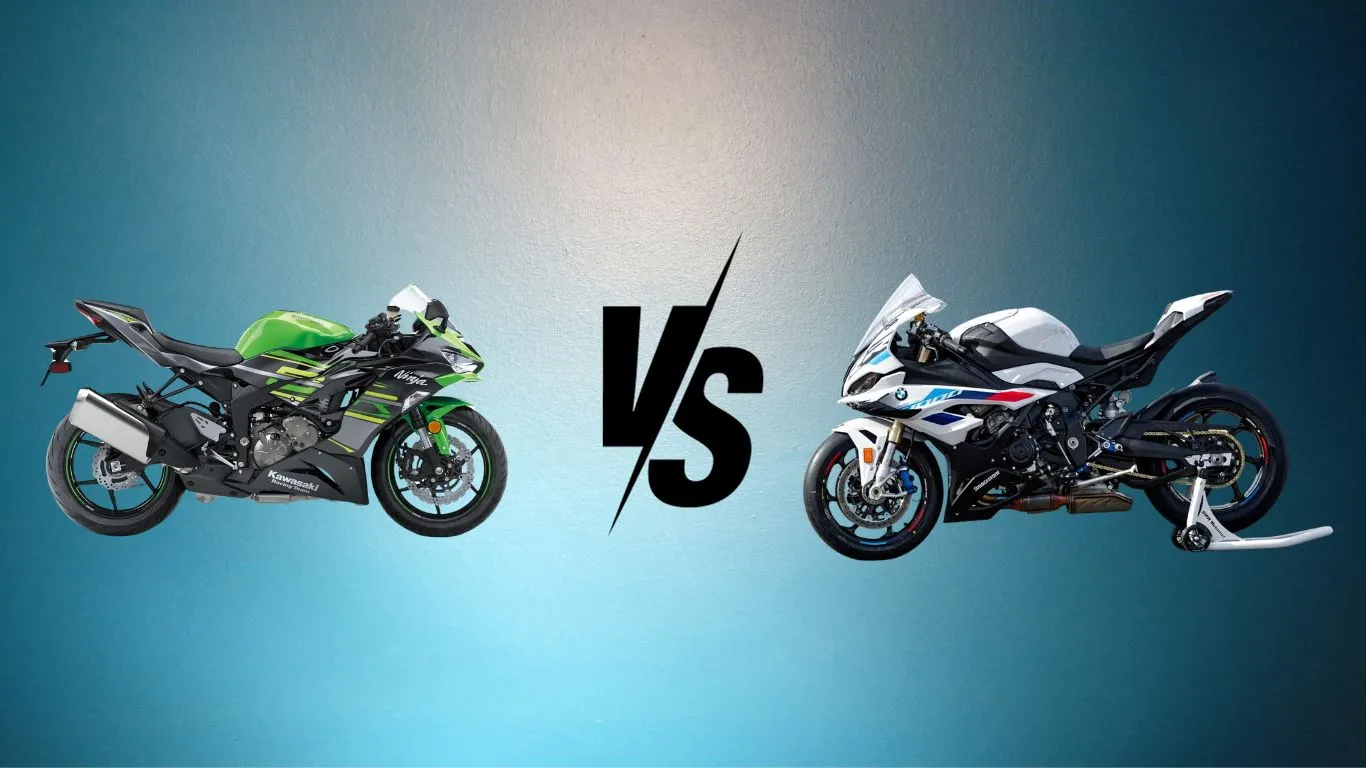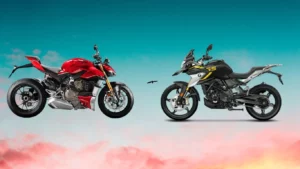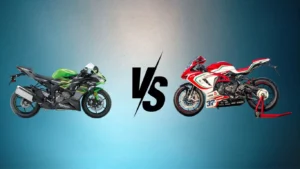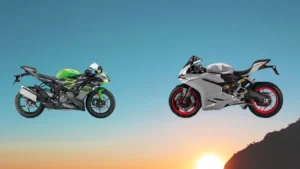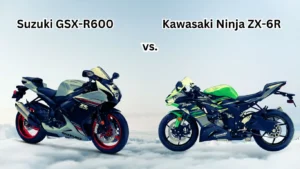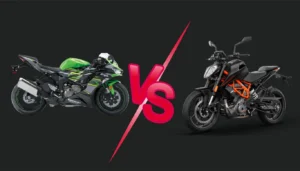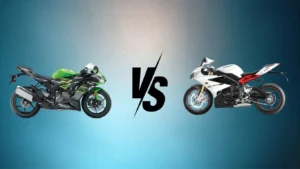Are you ready to dive into the high-tech world of today’s most advanced sportbikes, the Kawasaki Ninja ZX-6R and the BMW S1000RR? These machines not only deliver jaw-dropping speed but also state-of-the-art technologies, which we’re going to compare. You may feel like you’ve jumped into the future as you read about their astounding features.
From electronic aids helping you ride safer to connectivity options that offer a seamless integration of your bike with your digital life, these two bikes lead the pack. Let’s take a closer look at how these technologies compare on the Kawasaki Ninja ZX-6R and the BMW S1000RR, allowing you to decide which of these high-performance sportbikes fits you best.
Unveiling the Tech Giants: Kawasaki Ninja ZX-6R and BMW S1000RR
In the endless rivalry between major motorcycle manufacturers Kawasaki and BMW, we leave no stone unturned. The focus today is to analyze the superior breeds of both spectrums—Kawasaki Ninja ZX-6R and BMW S1000RR—with an emphasis on their technological features, electronic aids, and connectivity options.
We’ll sift through the most significant aspects of these two-wheelers, taking note of outstanding features and pointing out where each machine eclipses the other.
Technological Prowess At Play
With technology at the crux of their makeup, both the Kawasaki Ninja ZX-6R and the BMW S1000RR stand tall as awe-inspiring machines engineered veneration.
They are equipped with advanced features like onboard computers, multifunctional displays, and cutting-edge security among others, setting both bikes squarely at the shrines of their respective manufacturers’ prowess.
Electronic Aids that Inspire Confidence
Electronic rider aids are a vital cog in the machinery of these remarkable motorcycles. From the Kawasaki Ninja ZX-6R’s technologically advanced launch control to the BMW S1000RR’s sophisticated electronic suspension adjustments, each bike has its unique flavor of electronic assists aimed at amplifying the rider’s control and sharpening their confidence.
Connectivity Options that Modernize
Riding Bringing smartphones to the handlebars, each machine offers an array of connectivity options that modernize the ride.
Regardless of whether you want to sync your favorite routes, switch music tracks, or simply stay connected on the go with smartphone integration, these bikes offer a tantalizing glimpse into the future of motorcycling.
State-of-the-Art Security Features
Both Kawasaki and BMW are stalwart providers of motorcycle security, bestowing their high-end models with an array of safeguards. From the Ninja’s KIBS (Kawasaki Intelligent anti-lock Brake System) to BMW’s ASC (Automatic Stability Control), security onboard these machines is impeccably maintained.
Understanding the Technological Marvels: Key Features of Kawasaki Ninja ZX-6R
Imagine mounting a machine that’s not just about speed and agility, but also packed with cutting-edge technology to maximize performance and safety.
This is precisely what the Kawasaki Ninja ZX-6R offers. Let’s dive into its key technological features that contribute towards its laudable reputation in the motorbiking fraternity.
Engine Control Unit (ECU): The Electronic Heart
The Ninja ZX-6R brags of a potent Engine Control Unit (ECU)—the motorcycle’s electronic heart.
The ECU optimizes fuel combustion, thereby boosting the bike’s performance and fuel efficiency. It ensures an exhilarating ride without a hefty gas station bill.
Intelligent ABS system
Braking is a critical aspect of biking, more so at high speeds. The ZX-6R’s ABS system employs Kawasaki Intelligent anti-lock Brake System (KIBS), a technologically forward feature that provides safer, more responsive braking.
This system reduces the likelihood of wheel lock under intense deceleration, thus ensuring a more secured ride.
Traction Control System: Ensuring a Stable Ride
Kawasaki’s proprietary Traction Control System (TCS) comes standard in the ZX-6R.
This system evaluates wheel speed, throttle position, and other parameters, thereby optimizing power delivery and preventing loss of control.
Whether it’s a slippery road or a steep slope, the TCS assures a stable, worry-free ride.
Quick Shift System: Power at Your Fingertips
The ZX-6R features Kawasaki’s Quick Shift System (KQS), enabling seamless upshifts and downshifts without the use of the clutch.
This system significantly ramps up riding comfort and reduces gear shift times for a more satisfying high-speed experience.
The Assist & Slipper Clutch: Making Engagements Smoother
Rounding off our exploration of the Ninja’s tech marvels is the Assist & Slipper Clutch. This clutch brings a lighter feel at the lever, reducing rider fatigue over extended trips.
Additionally, it also prevents wheel hop when downshifting at high speeds, making for a smoother, more controlled experience.
Deciphering the Tech Masterpiece: Key Features of BMW S1000RR
Let’s dive into the world of tech masterpieces on two wheels – the BMW S1000RR. It’s not just the fierce acceleration and impressive top-speed that make the BMW S1000RR stand out; it’s the blend of high-tech features and user-friendly electronics that solidify its superiority.
It’s like a Technicolor dream disguised in a motorcycle frame, relentlessly pushing the boundaries of intelligence, precision, and real-time adjustments.
From the heart of the beast – its engine control unit – through to its ABS Pro and Gear Shift Assist Pro, you are about to discover just how tech-rich and fully-loaded the BMW S1000RR truly is.
The Powerhouse: Engine Control Unit (ECU)
The magic starts with the BMW S1000RR’s Engine Control Unit (ECU). This smart center is the brain of the bike, continuously optimizing ignition timing, fuel delivery, and multiple aspects influencing performance based on various parameters, including speed and terrain.
The dynamic ECU allows for precise benchmarks, resulting in smooth, yet potent power delivery across the rev range.
ABS Pro: Safety in Turns While Braking
The BMW S1000RR comes equipped with an ABS Pro, a groundbreaking safety feature that brings stability and confidence, even while negotiating tight corners at speed.
This system enhances control by preventing wheel lockup during acute braking situations, providing you with the much-needed control and stability when it matters the most.
D-TC Dynamic Traction Control: When Speed Meets Safety
The S1000RR includes the D-TC Dynamic Traction Control system, which uses intelligent calculations to limit wheel spin without killing the thrill of acceleration.
By gauging the bike’s banking angle and speed, this system adjusts the power delivery ensuring an optimal balance between traction and speed.
Gear Shift Assist Pro: Quicker, Easier Shifts
Incorporating an exclusive feature, the Gear Shift Assist Pro, the BMW S1000RR offers effortless gear transitions without the necessity for clutch engagement.
This substantially cuts down on the time taken for gear shifting and paves the way for continuous acceleration, resulting in a ride that’s both smoother and swifter.
Dynamic ESA: Instant Suspension Adjustments
Dynamic ESA (Electronic Suspension Adjustment) brings a new layer of sophistication to handling.
This system monitors and adapts the suspension settings in real-time based on road conditions and riding style, offering you the ultimate in comfort and performance during your rides.
Electronic Aids: A Comparative Study between Kawasaki Ninja ZX-6R and BMW S1000RR
Throughout this section, we’ll delve into the electronic assists that come with both the Kawasaki Ninja ZX-6R and the BMW S1000RR. These modern marvels, engineered to perfection, are decked out with fantastic electronic aids, reaffirming their place at the top of their respective performance categories.
These aids not only accentuate the overall riding experience but also provide an enhanced dimension of safety and control for the riders. Let’s break it down and compare what’s offered in each machine.
Stability Control in High Speeds
The Kawasaki Ninja ZX-6R showcases its prowess with its remarkable traction control system. It offers three modes to choose from based on rider preference and conditions, proving its adaptability in various scenarios. This system aids in maintaining stability at high speeds, establishing an enjoyable and safe riding experience.
Likewise, the BMW S1000RR is not to be outdone in this arena, boasting an impressive D-TC Dynamic Traction Control feature. This advanced system is designed to increase safety while delivering higher performance, a must-have for speed enthusiasts who won’t compromise safety.
Effortless Gear Shift Experience
Both motorcycles offer quick shift systems to elevate the rider’s experience. The Ninja ZX-6R utilizes its quick shift system to provide the rider with seamless power delivery during gear changes. The system cuts off the engine momentarily for a smooth shift, thus, allowing the rider to maintain throttle position during shifts.
On the other hand, the BMW S1000RR takes gear shifting to new heights with the Gear Shift Assist Pro. This system allows faster and easier gear shifts both upwards and downwards without the need of the clutch. The rider enjoys the comfort of uninterrupted acceleration while preserving the bike’s balance and traction stability
Advanced ABS in Action
The commitment to safety is exemplified in both bikes. The Kawasaki Ninja ZX-6R is equipped with an intelligent ABS system. This system fuses Kawasaki’s own ABS technology with the front and rear wheel sensors to optimize brake force, reducing the risk of wheel lock up during sudden braking.
The BMW S1000RR features the ABS Pro function, a system designed for safety during harsh braking. Particularly useful in turns, the ABS Pro ensures stable and safe braking at all times. It effectively optimizes brake force distribution to counter over-braking in dangerous situations.
Connectivity Options: From Smartphone Integration to GPS Navigation
In today’s digital era, motorcycle manufacturers are going above and beyond to provide advanced connectivity options, fueling both convenience and safety.
Both the Kawasaki Ninja ZX-6R and BMW S1000RR excel in integrating modern technology, offering riders an enriched on-road experience with features such as smartphone compatibility, GPS navigation, real-time updates, and much more.
Smartphone Integration: Bridging the Gap Between Technology and Convenience
Say hello to advanced motorcycle connectivity with smartphone integration on both these stunning beasts. The Kawasaki Ninja ZX-6R sports elevated smartphone connectivity through its Rideology app, which allows complete smartphone-sync and provides access to vehicle information, riding logs, and more.
In contrast, the BMW S1000RR offers the BMW Motorrad Connected App that doesn’t just relay motorcycle data on your phone screen but also navigational cues and ride statistics. This unprecedented convenience offered by these motorcycles brings technology and comfort at your fingertips.
GPS Navigation: Never Lose Your Way Again
The thrill of a ride can often lead you off the beaten path, but the advanced GPS navigation systems in Kawasaki Ninja ZX-6R and BMW S1000RR ensure you never lose your way.
Both motorcycles feature integrated GPS systems providing precise navigational data. The BMW S1000RR further elevates this by reflecting GPS navigation instructions directly on the multi-function display, thus allowing riders to focus on the road.
Kawasaki Ninja ZX-6R: A Closer Look at On-Board Computer and Display
In the pulsating heart of any contemporary motorcycle lies an on-board computer, a technological marvel tasked with managing various operations and providing key data to the rider. It is with this data that you, the rider, can enhance your riding experience and manage your machine better.
And who does it better than the Kawasaki Ninja ZX-6R with its advanced technological features, specifically engineered to empower the rider and boost their riding experience.
Power Packed On-Board Computer: Your Dashboard for Everything
The on-board computer of the Kawasaki Ninja ZX-6R is built to deliver. This powerful device, integrated within the motorcycle, handles your bike’s performance and provides you with a plethora of real-time data. This includes fuel consumption, riding range, average speed, total time ridden, and more.
The computer’s intuitive design allows for a straightforward user operation, letting you remain in control of all aspects of your ride.
The Display: High-Res & Easy to Read
When it comes to displays, the Ninja ZX-6R doesn’t joke around. Its display is crisp, clear, and easy to read even during the brightest of days. This is more than just a tool—it’s a window into the heart of your machine.
Conveying critical information such as gear indicator, speedometer, tachometer, and fuel gauge, this high-res LCD screen ensures you’re always in the loop.
Multifaceted Customizable Settings: Tailored for You
The Kawasaki ZX-6R’s on-board computer introduces a new dimension of customization to your riding experience. It offers detailed insight into different metrics and lets you fine-tune your machine according to your preferences.
Elements such as power modes, traction controls and ABS deployment are programmable, giving you the freedom to mold the bike’s performance to your precise wishes.
Riding Aid Notifications: For a Secure Ride
The Kawasaki Ninja ZX-6R features instant notifications for its riding aids, emphasizing a safe ride. Warnings for factors such as low fuel, high engine temperature, and excessive speed flash on the easy-to-read display, keeping you informed and attentive.
On the other hand, the BMW S1000RR also incorporates prompt safety alerts into its multifunction display, ensuring any irregularities are swiftly highlighted to the rider. It’s all about prioritizing safety without compromising on the thrill of riding.
BMW S1000RR: An Examination of the Multi-Function Display and Connectivity
Stepping inside the digital cockpit of the BMW S1000RR is akin to navigating a technologically advanced spacecraft.
The motorcycle boasts a multi-function display and a plethora of connectivity options that raise the bar for its competitors.
This space-age technology doesn’t just make riding more convenient and informative, but cements the S1000RR’s position as a true marvel of engineering.
Multi-Function Display: The Window to Your Bike’s Soul
The BMW S1000RR showcases its technological prowess via a 6.5-inch TFT multi-function display. The display is not just visually appealing but makes the riders feel in absolute control.
It provides clear, concise, and instant information about various metrics such as gear position, speed, engine rpm, as well as warnings and notifications such as oil pressure, engine temperature, and more.
While maintaining an undeniable charm, the display successfully integrates ergonomics, design, and function.
Connectivity Plus: Making Your Ride Smarter
BMW takes rider connectivity to the next level, enhancing your interaction with the bike, surroundings, and even your smartphone. With the BMW Motorrad Connected App, you can have GPS route navigation, fingertip call handling, and music control, all displayed on your TFT screen. Now, imagine planning your route on your phone, transferring it to your bike, and awake the adventurer in you. This is not just fancy tech but a key feature that helps you explore and enjoy the ride, making it an integral part of all BMW motorcycles.
Safety Alerts and Notifications: Keeping You Informed
The BMW S1000RR ensures rider safety in real-time by using its state-of-the-art sensors and computing capabilities. The motorcycle continuously monitors its suspension, braking, and engine systems and will alert you when something is off.
For example, a drop in tire pressure, unusual engine behavior, or braking system irregularities will prompt instant alerts. This preemptive warning system drastically increases rider safety, giving you peace of mind on every journey.
High-End Performance Meets High-Tech: The Engine Technology of Kawasaki Ninja ZX-6R and BMW S1000RR
Underneath the sleek exteriors of both Kawasaki Ninja ZX-6R and BMW S1000RR lies robust engine technology that propels these machines to the forefront of motorcycling innovation.
Along with high-performance capabilities, these motorcycles embrace cutting-edge technology, revolutionizing their engine operations, thus delivering maximum power, efficiency, and reliability that discerning riders covet.
Let’s delve into the engine technology involved.
Engine Innovation: More Than Just Horsepower
At the heart of both the Kawasaki Ninja ZX-6R and the BMW S1000RR are intricately engineered engines designed for speed, performance, and durability.
Both bikes have engines expertly crafted with technologies that enhance power output and fuel efficiency. Inline-four engines are the norm in these sport-bikes, offering a balance of power and tractability favored by riders worldwide.
Combustion Efficiency: Masterful Performance Meets Prudent Fuel Economy
Both motorbikes employ sophisticated fuel injection systems to boost combustion efficiency. Kawasaki features its Dual Throttle Valves technology, aiding better fuel-air mixture for optimal combustion, while BMW comes with an innovative fuel injection system which monitors and adjusts fuel supply for maximized efficiency.
Both result in powerful performances without compromising fuel economy which is paramount in today’s environmentally-conscious world.
Cooling Systems: Managing the Heat of High Performance
High-performance engines generate a lot of heat, and managing this heat effectively is key to maintaining engine health and performance. Both Kawasaki and BMW deploy liquid cooling systems for temperature control. This enhances the bikes’ reliability and longevity by preventing overheating, thereby ensuring you continue to enjoy superior performance ride after ride.
Engine Management Systems: Optimizing Performance for Every Ride
From Kawasaki’s ECU to BMW’s BMS-X, these bikes’ engine management systems showcase technological expertise.
This technology helps monitor and subdue engine functions, providing ideal output from ignition timing to valve operation, irrespective of riding conditions.
Embedded sensor systems feed data to the processor, dynamically managing the engine parameters, thus ensuring optimal performance, every single time.
Kawasaki versus BMW: Who Has the Better Security Features?
When we’re discussing high-tech motorcycles like Kawasaki Ninja ZX-6R and BMW S1000RR, it’s impossible not to mention the advanced security features these models boast.
Equipped with the latest technology, both bikes offer impressive security features, designed to safeguard not only the motorcycles themselves but also enhance rider safety. Let’s compare and contrast these features in the following sections.
A Word on Anti-Theft Protection
One significant aspect of motorcycle security is protection against theft. Both Kawasaki Ninja ZX-6R and BMW S1000RR go beyond the traditional mechanical locks or immobilizers.
The Kawasaki Ninja ZX-6R includes an ignition switch that doubles as a steering lock, deterring would-be thieves. On the other hand, BMW S1000RR takes it a notch higher with its optional anti-theft alarm system that sends an alert when the bike is moved or tampered with, boosting your peace of mind when the bike is unattended.
Brake Locks for Additional Security
Brake locks can be a convenient and efficient tool to provide an additional layer of security, and both the Ninja and the BMW offer this feature.
Kawasaki supplies an optional disc lock with an integrated alarm system for the Ninja ZX-6R. In contrast, BMW equips the S1000RR with an automatic brake disc recognition system that works in conjunction with the brake disc lock, enhancing the overall security level.
Riding Safety
While riding security may not seem like a ‘security feature’ in the traditional sense, ensuring the safety of the rider while on the move is of utmost importance and both these motorcycles provide a plethora of features in this regard.
The Ninja ZX-6R features a safety package that includes cornering management function, intelligent ABS and a three-mode traction control system, providing the rider with a safe and stable ride in various road conditions. Meanwhile, the S1000RR boasts its ABS Pro, Dynamic Traction Control and Dynamic Damping Control features for secure and stable riding while negotiating sharp corners and high-speed straights alike.
Advancements in Suspension and Braking: A Look into Kawasaki Ninja ZX-6R and BMW S1000RR
As you embark on your journey with either the Kawasaki Ninja ZX-6R or the BMW S1000RR, rest assured that both motorcycles are engineered to provide an exceptional ride quality and safety.
They are both graced with state-of-the-art suspension and braking systems that not only aim to ensure your security but also factor considerably into the overall performance of the motorcycles.
When dealing with high-performance machines, advanced suspensions and braking technologies can make the difference between a fantastic ride and a dangerous one. Let’s delve into these features to better understand their significance.
Pioneering Suspension Technology
Both the Kawasaki Ninja ZX-6R and the BMW S1000RR exhibit ground-breaking suspension technology.
But, while the ZX-6R boasts of a Showa Balance Free Fork and fully adjustable monoshock on the rear, the S1000RR impresses with its Dynamic Damping Control (DDC) system, providing an adaptive suspension solution.
These technologically advanced suspension systems are designed to deal with different terrain types and ride situations, providing superior control, comfort, and ride quality.
Braking Systems: Combining Safety & Performance
The ZX-6R and the S1000RR push the boundaries when it comes to their braking systems. The ZX-6R features dual 310mm semi-floating petal discs up front and a single 220mm petal disc on the rear, coupled with an advanced anti-lock braking system.
On the other hand, the S1000RR sports twin 320mm discs upfront and a single 220mm disc on the rear, supported by its superior ABS Pro system. The end result? Powerful, responsive braking that promises to elevate your ride’s safety and overall performance.
Comparing the Aerodynamics: How Kawasaki Ninja ZX-6R Stacks Up Against BMW S1000RR
When analyzing the aerodynamics of a sports bike, few aspects are as critical as the design and build quality. It significantly influences a bike’s performance and the rider’s comfort.
As we delve into the aerodynamics of both Kawasaki Ninja ZX-6R and BMW S1000RR, it’s evident that both these tech beasts employ advanced aerodynamic designs to improve speed, maneuverability, and fuel efficiency. However, there are subtle differences that make each of them unique in their own right.
A Study in Streamlining: Kawasaki Ninja ZX-6R
The Ninja ZX-6R, brought into existence by Japan’s most significant two-wheeler manufacturer, is a product of intensive aerodynamics research. Its bodywork uses a sharp, aggressive design, imbibing elements of the famed Ninja ZX-10R’s style, to direct wind around the motorcycle in the most efficient way possible.
This not only helps in reducing air drag but also stabilizes the motorcycle at higher speeds. The aerodynamic design also works in harmony with the ZX-6R’s compact chassis design to offer a seamless blend of speed and control.
Engineering Vs. Air Resistance: BMW S1000RR
BMW has always been synonymous with precision and the S1000RR is no different. This machine has been reimagined from the ground up for an even more incredible aerodynamic performance.
The S1000RR boasts a lighter, more compact design with strategically placed fairings and a lower weight for easier handling. Its aerodynamic design, combined with a streamlined bodywork and an asymmetrical front headlamp, enables it to cut through the air effortlessly.
The bike is engineered including the smallest details such as winglets and gills to maximize wind-cutting efficiency and maintain stability, even at daunting speeds.
Overall Assessment
Kawasaki Ninja ZX-6R and BMW S1000RR represent the pinnacle of motorcycle technology, inspiring awe with their advanced features and convenient connectivity options. The Kawasaki ZX-6R impresses with its intelligent ABS and Quick Shift System, while the BMW S1000RR stands out with its Dynamic Traction Control and Gear Shift Assist Pro.
At the end of the day, the choice between these two powerhouses boils down to personal preference, as both motorcycles exemplify technological mastery. From smartphone integration to advanced ABS systems, each motorcycle offers distinctive technical quirks that make them unique and incredibly enticing.
Tire Pressure Monitoring and More: Unpacking the Safety Tech in Kawasaki and BMW
The advanced safety technology that Kawasaki Ninja ZX-6R and BMW S1000RR integrate enhances your ride, ensuring it doesn’t just reach the climax of speed but also of safety.
These cutting-edge machines employ tire pressure monitoring systems alongside other safety measures, which work in collaboration to provide you a smoother, more secure ride.
Foresight on Wheels: Tire Pressure Monitoring System (TPMS)
Both Kawasaki Ninja ZX-6R and BMW S1000RR understand the importance of optimum tire pressure for a safe, efficient ride and include advanced TPMS.
This crucial system constantly monitors tire pressure, alerting riders if the pressure falls below or goes above the desired level.
It brings about increased traction, better fuel efficiency, and longer tire life by maintaining optimum pressure. Tire pressure information is prominently displayed on the dash, allowing you to take corrective action in time.
Lighting the Way: Adaptive Headlight Technology
The ZX-6R and S1000RR do not compromise on rider visibility. These bikes are equipped with adaptive headlights that adjust according to the bike’s lean and speed.
Such dynamic lighting improves visibility in corners and during night-time rides, ensuring your safety in tricky lighting conditions.
The BMW S1000RR takes it up a notch with its symmetrical adaptive headlights; these not only pivot into turns but also provide uniform light distribution.
Endowing the Rider: Rider Alert Systems
Advanced rider alert systems in these machines work tirelessly to keep you safe. They continually monitor crucial parameters like engine temperature, oil levels, and battery health and alert riders of any abnormalities.
The BMW S1000RR goes a step further with its Hill Start Control feature, stopping the motorcycle from rolling backwards on an incline. This feature, paired with its advanced fire detection system, makes the S1000RR a leading figure in motorcycle safety technology.
Trumps of the Trade: Cornering ABS and Stability Control
Cornering ABS, an essential safety feature in both Kawasaki Ninja ZX-6R and BMW S1000RR, adjusts brakes according to the lean angle. This ensures safer braking while cornering, reducing the chances of skidding. Also, the Stability Control ensures a balanced ride by controlling excessive wheel spin during acceleration on slippery surfaces or quick throttle release.
The BMW S1000RR steps up its game with Dynamic Stability Control, a feature that mitigates wheel spin and enhances rider safety. These features consolidate the reputation of these bikes as technologically advanced marvels.
Diving into the Unique Tech Features: Kawasaki Ninja ZX-6R vs BMW S1000RR
Boiling down the hi-tech thresholds of Kawasaki Ninja ZX-6R and BMW S1000RR to unique features, we find symbols of relentless innovation.
These majestic beasts, with their advanced technology, gift us a riding experience that’s both empowering and exhilarating.
Let us saddle up to explore the unique technological aspects that separate these machines from their competitors, and against each other.
Chassis Technology: A Collision of Strength and Flexibility
A motorcycle’s chassis is its backbone, and both Kawasaki and BMW have outdone themselves in this department.
The ZX-6R, with its aluminum perimeter frame, delivers excellent balance and superior handling, even on tricky terrains.
Not to be outdone, the BMW S1000RR, built around an aluminum composite bridge frame, facilitates optimal rigidity and load-bearing capacity, keeping your ride steady no matter what.
Digital Ignition:
A Spark of Genius Ignition systems heavily influence performance, and both Ninja ZX-6R and S1000RR represent the cutting edge in this regard.
Kawasaki’s digital ignition system ensures rapid engine start-up and optimal combustion, thus enhancing both performance and fuel efficiency.
On the other side, BMW’s proprietary ignition system ensures optimal ignition timing across all riding conditions, contributing to the S1000RR’s beastly performance.
Precision Fuel Injection: Masterful Fuel Management
Fuel injection systems in both bikes are yet another testament to their technological prowess. The ZX-6R boasts a DFI® system with four 38mm Keihin throttle bodies and oval sub-throttles contributing to exact fuel-air mix and a smoother engine response.
The S1000RR features a closed-loop 3-way catalytic converter and an interference pipe, elevating horsepower and torque while also promoting enhanced fuel economy.
Shift Assist System: Seamless Gear Shifts
This invariably results in swifter acceleration and decreased lap timings.
Fast, efficient, and easy on the rider, these shift assist systems highlight the technological edge that both bikes possess. Ensuring seamless transitions between gears, these systems don’t just enhance ride quality, they redefine it.
Conclusion
In conclusion, the Kawasaki Ninja ZX-6R and the BMW S1000RR both bring extraordinary technological prowess, electronic aids, and connectivity options to the table. They offer riders an array of features like high-performance engine control units, ABS systems, traction control, and advanced GPS to enhance the riding experience. They each have their unique strengths and are tailored for different riding preferences.
Regardless of your choice, you will be getting a bike that pushes the boundaries of what’s possible in motorcycle technology. These two powerhouses truly showcase the strides we’ve made in integrating tech into our rides. Ride with confidence and experience cutting-edge features with the ZX-6R or S1000RR.
